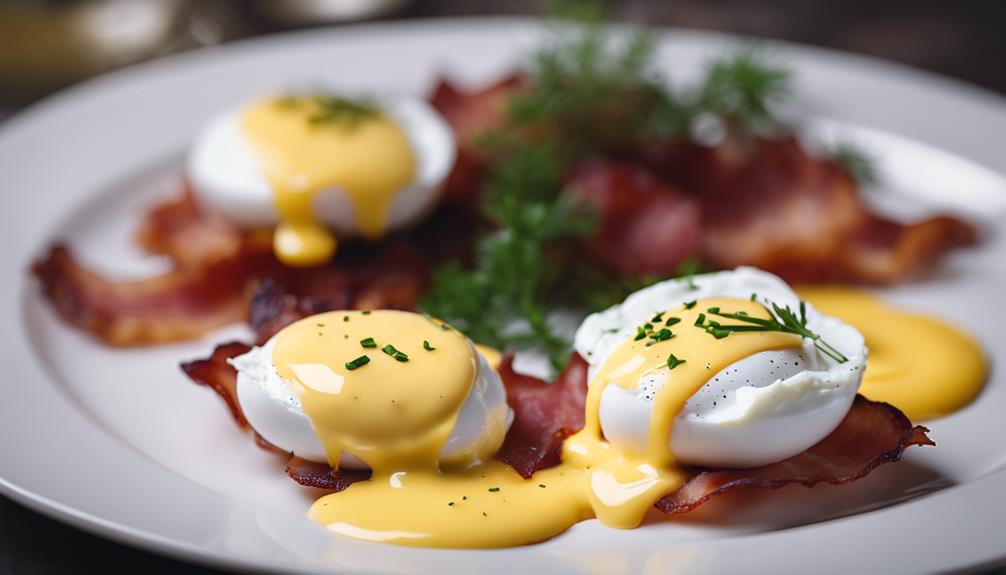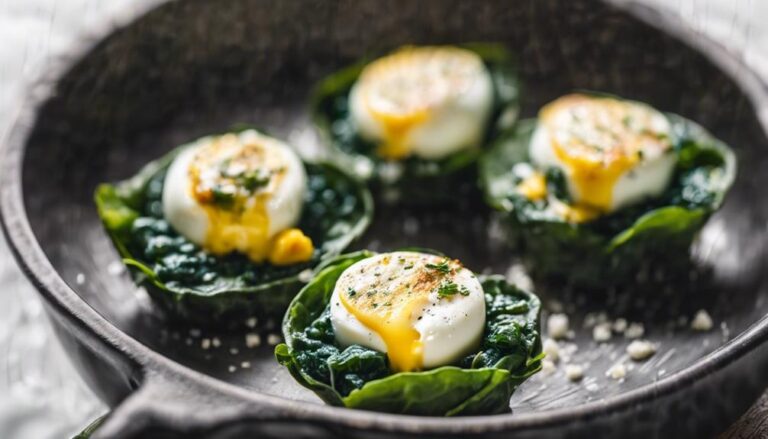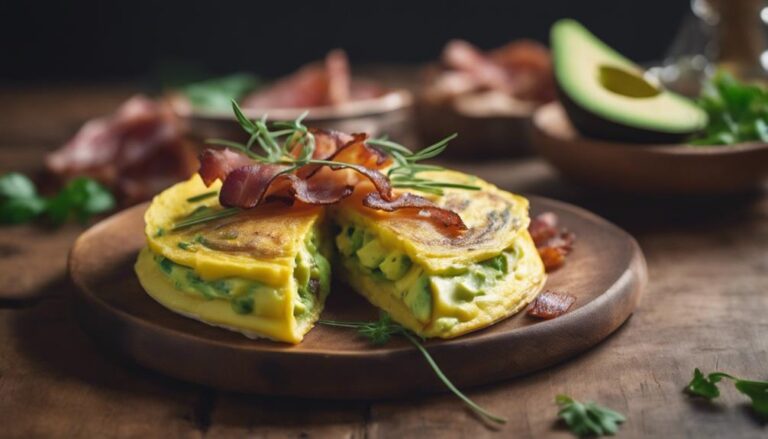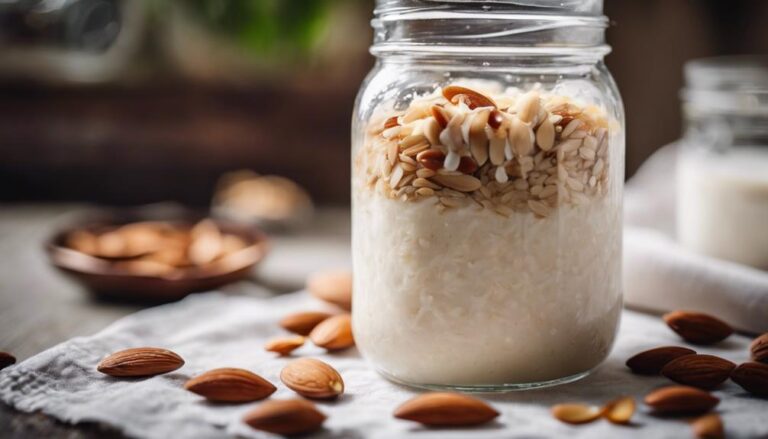Keto Sous Vide Hollandaise Sauce Over Poached Eggs
Indulge in a keto-friendly treat with sous vide Hollandaise sauce over poached eggs. Start by preparing a traditional Hollandaise sauce with egg yolks, butter, and lemon juice. Use a sous vide machine for precise temperature control, ensuring a perfectly cooked sauce. Sous vide cooking maintains flavors and nutrients, resulting in a rich, creamy texture. Drizzle the velvety sauce over poached eggs for a decadent low-carb, high-fat meal. Elevate your breakfast experience with this delicious and healthy dish. Enhance your culinary skills by exploring the fusion of flavors in this delightful dish.
What You Will Learn Here
- Sous vide ensures precise temperature control for perfect hollandaise consistency.
- Even cooking distribution in sous vide maintains hollandaise texture and flavor.
- Retained flavors and nutrients in sous vide elevate keto hollandaise sauce quality.
- Keto hollandaise sauce rich in egg yolks complements poached eggs beautifully.
- Modern twists like Chipotle Hollandaise add exciting flavors to keto-friendly dish.
Origin of Hollandaise Sauce

Hollandaise sauce has a rich history, with roots tracing back to French cuisine in the 17th century.
The classic ingredients of Hollandaise include egg yolks, butter, lemon juice, and a touch of seasoning.
Over time, this velvety sauce has been adapted and transformed into various versions to suit different culinary preferences and dietary needs.
History of Hollandaise
Originating in France in the 17th century, this creamy and tangy sauce found its place among the culinary delights of the time. The history of Hollandaise sauce reflects a culinary evolution shaped by cultural influences.
Initially known as 'Sauce Isigny' due to the use of Isigny butter, it later transformed into the Hollandaise we recognize today. This evolution was marked by the incorporation of egg yolks and lemon juice, giving the sauce its characteristic richness and tanginess.
The French culinary tradition played a significant role in refining the sauce, which eventually spread beyond France to become a staple in classic cuisine worldwide. The delicate balance of flavors in Hollandaise sauce showcases the innovative spirit of culinary history, making it a timeless favorite.
Classic Hollandaise Ingredients
Investigating the traditional ingredients used in crafting the renowned Hollandaise sauce reveals a harmonious blend of rich Isigny butter, velvety egg yolks, and zesty lemon juice. These classic components form the base of the sauce, with the butter providing a luxurious richness, the egg yolks lending a velvety texture, and the lemon juice adding a bright, tangy flavor.
Classic techniques involve emulsifying these ingredients over gentle heat to create a smooth and creamy sauce. However, modern twists on the traditional recipe may include incorporating different types of butter for unique flavor profiles, experimenting with flavored vinegars in place of lemon juice, or even infusing herbs or spices to add depth and complexity to this beloved sauce.
Variations and Adaptations
How have chefs across culinary history creatively adapted and personalized the traditional Hollandaise sauce recipe? Chefs have been known to experiment with a variety of flavor profiles and presentations to put their own spin on this classic sauce. By incorporating flavorful substitutions and creative presentations, they have elevated the traditional Hollandaise sauce to new heights. Texture experimentation and ingredient substitutions have also played a significant role in the evolution of this sauce, allowing for unique and innovative culinary creations. Below is a table showcasing some examples of variations and adaptations that chefs have implemented over time:
| Variation | Description | Example |
|---|---|---|
| Flavorful Substitutions | Swapping traditional ingredients for more intense flavors | Chipotle Hollandaise |
| Creative Presentations | Artistic ways of serving the sauce to enhance visual appeal | Hollandaise spheres |
| Texture Experimentation | Playing with thickness or smoothness of the sauce | Light and airy Hollandaise |
| Ingredient Substitutions | Using alternative ingredients to cater to dietary preferences | Vegan Hollandaise |
Egg Yolks for Hollandaise
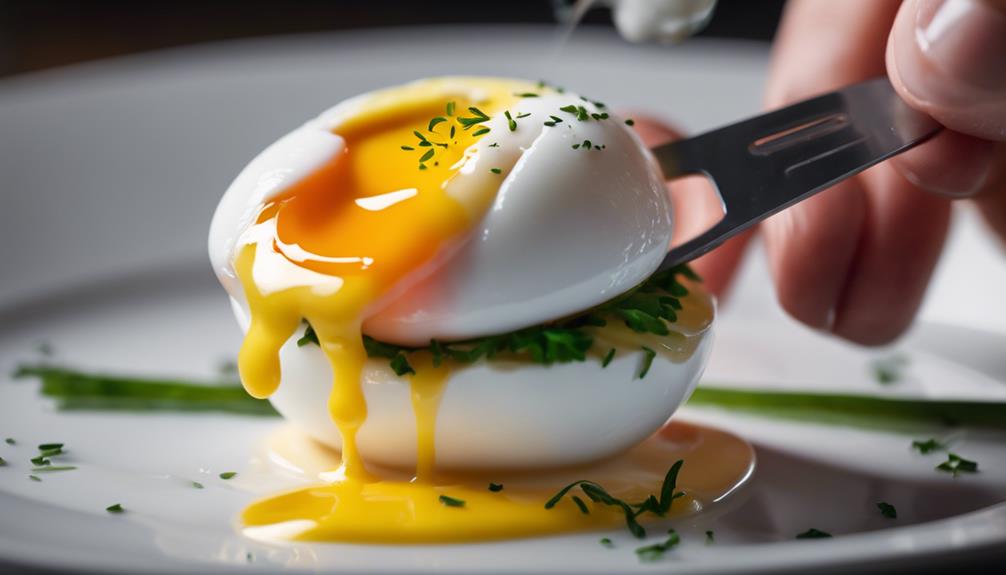
To achieve the rich and creamy consistency of a classic Hollandaise sauce, whisk together egg yolks with a touch of acidity and seasonings over gentle heat. Egg yolks play an important role in the creation of Hollandaise sauce, providing both flavor and texture.
Here are some key points to keep in mind when working with egg yolks for your Hollandaise sauce:
- Emulsification: Egg yolks act as an emulsifier, helping to bind the butter and lemon juice together into a smooth sauce.
- Richness: The natural fats in egg yolks contribute to the luxurious richness of the Hollandaise sauce.
- Color: Egg yolks give the sauce its vibrant yellow color, adding to the visual appeal of the dish.
- Nutrients: Egg yolks are a good source of vitamins and minerals, providing additional nutritional benefits to the sauce.
- Temperature Sensitivity: Be cautious when heating the egg yolks to prevent scrambling; a gentle heat is key to achieving the desired consistency.
Trending Hollandaise Sauce Variations
You'll find exciting variations in the trending Hollandaise sauce sphere, such as the Sous Vide Eggs Benedict Recipe, an innovative take on the classic dish.
Don't miss out on the Egg-Free Hollandaise Twist, perfect for those with dietary restrictions or allergies.
If you're feeling adventurous, give the Sous Vide Hollandaise With Lobster a try for a luxurious and indulgent twist on a traditional sauce.
Sous Vide Eggs Benedict Recipe
Wondering what sets this Sous Vide Eggs Benedict Recipe apart from the traditional version? When it comes to innovative breakfast ideas, this recipe takes the classic Eggs Benedict to a whole new level. Here are five key elements that make this dish a standout:
- Perfectly Cooked Sous Vide Eggs: Sous vide cooking guarantees your eggs are precisely cooked to the desired consistency.
- Sous Vide Hollandaise Sauce: The hollandaise sauce prepared sous vide style offers a velvety texture and rich flavor.
- Sous Vide Bacon: Adding sous vide bacon provides a unique twist and enhances the dish's overall taste.
- Herb-infused Butter: Infusing butter with herbs using sous vide elevates the flavor profile of the dish.
- Sous Vide English Muffins: Even the English muffins are taken up a notch with a sous vide preparation, ensuring a perfect texture.
Egg-Free Hollandaise Twist
For a modern twist on the classic hollandaise sauce, consider experimenting with an egg-free variation that's gaining popularity among culinary enthusiasts. Here are some innovative ideas to elevate your egg-free hollandaise experience:
- Explore vegan alternatives by replacing eggs with silken tofu or cashews for a creamy texture.
- Opt for low carb options by using coconut cream or avocado as the base for a keto-friendly hollandaise sauce.
- Enhance flavors with nutritional yeast, turmeric, or Dijon mustard for a unique taste profile.
- Experiment with different acid sources like lemon juice, apple cider vinegar, or white wine vinegar for a tangy kick.
- Adjust the consistency by adding plant-based milk or vegetable broth until you reach your desired thickness.
Sous Vide Hollandaise With Lobster
To enhance your hollandaise sauce experience, contemplate incorporating the luxurious touch of sous vide cooking with lobster, creating a trending variation that ensures a decadent twist on this classic sauce. When exploring the world of lobster pairing and keto-friendly adaptations in hollandaise sauce, here are five key points to ponder:
- Sous Vide Perfection: Utilize sous vide cooking to infuse the lobster's rich flavors seamlessly into the hollandaise.
- Keto-Friendly Swaps: Experiment with keto-friendly ingredients like ghee or avocado oil for a healthier twist.
- Balancing Flavors: Achieve a harmonious blend of buttery lobster and velvety hollandaise with a hint of acidity.
- Texture Matters: Aim for a velvety smooth texture in your sauce to complement the succulent lobster meat.
- Garnish Elegance: Elevate your dish with a sprinkle of fresh herbs or a drizzle of clarified butter for a visually stunning presentation.
Sous Vide Cooking Techniques
When using sous vide cooking techniques, you benefit from precise temperature control, ensuring your food is cooked to perfection every time.
This method also provides even distribution of heat, resulting in consistent results throughout your dish.
Moreover, sous vide cooking helps retain the flavors and nutrients of the ingredients, giving you a delicious and nutritious final product.
Precise Temperature Control
Achieving precise temperature control is crucial in sous vide cooking for consistently perfect results. Maintaining the exact temperature throughout the cooking process guarantees that your food is cooked to perfection without the risk of overcooking or undercooking. Here is a table showcasing the different cooking methods and their recommended temperature precision:
| Cooking Method | Temperature Precision |
|---|---|
| Poached Eggs | 140°F |
| Medium-Rare Steak | 130°F |
| Salmon | 125°F |
| Asparagus | 185°F |
Even Cooking Distribution
For consistent and precise cooking results in sous vide techniques, ensuring even distribution of heat throughout the food is essential.
The even cooking process in sous vide involves submerging vacuum-sealed ingredients in a precisely controlled water bath, allowing for uniform heat transfer. This method eliminates the risk of hot spots or uneven cooking, resulting in perfectly cooked dishes every time.
By maintaining a constant temperature, flavors infuse harmoniously, enhancing the taste profile of the food.
The sous vide technique excels in evenly cooking delicate items like eggs or fish, preserving their tenderness and moisture.
With this meticulous approach, you can achieve restaurant-quality results in the comfort of your own kitchen, elevating your culinary creations to new heights.
Retained Flavors and Nutrients
To maximize the retention of flavors and nutrients in sous vide cooking techniques, a consistent and controlled temperature environment is crucial. This precise method guarantees that ingredients are cooked evenly without losing their natural essence, resulting in exceptional flavor retention and nutrient preservation.
By vacuum-sealing food in airtight bags and cooking them at low, steady temperatures for an extended period, the culinary benefits of sous vide cooking are amplified. This technique not only enhances the taste and texture of the food but also provides health advantages by preserving essential nutrients that can be lost through traditional cooking methods.
Sous vide cooking allows you to enjoy meals that aren't only delicious but also packed with retained flavors and nutrients for a truly satisfying dining experience.
Final Thoughts
In conclusion, contemplating on the preparation process and flavor profile of the Keto Sous Vide Hollandaise Sauce Over Poached Eggs reveals the intricate balance of textures and tastes that elevate this dish to a gourmet level. The velvety smoothness of the sous vide hollandaise sauce complements the delicate poached eggs perfectly, creating a harmonious blend of flavors that dance on your palate. The richness of the sauce, with its buttery and tangy notes, enhances the overall experience, making each bite a luxurious indulgence.
When serving this dish, consider topping it with a sprinkle of fresh herbs like chives or parsley to add a pop of color and a hint of freshness. To store any leftover hollandaise sauce, refrigerate it in an airtight container for up to 2 days, ensuring you gently reheat it before serving again to maintain its creamy consistency. These small details contribute to the overall success of this keto-friendly, sous vide masterpiece.
Frequently Asked Questions
Can This Hollandaise Sauce Be Made Ahead of Time and Stored for Later Use?
You can make the hollandaise sauce ahead of time and store it for later use. Freezing hollandaise is not advised as it can cause separation. Instead, refrigerate for up to 2 days for best taste. Sous vide tips guarantee a smooth, creamy consistency.
What Is the Best Way to Reheat Leftover Hollandaise Sauce Without It Breaking?
To reheat leftover hollandaise sauce, use a double boiler for gentle, gradual warming. Control temperatures carefully to prevent separation. Avoid direct heat to maintain sauce stability. Stir constantly for even consistency. This technique preserves the sauce's integrity.
Are There Any Substitutions for Butter in Hollandaise Sauce for Those With Dairy Allergies?
If you have a dairy allergy, consider dairy-free alternatives like ghee or coconut oil in hollandaise sauce. These swaps can offer unique flavor variations while ensuring your dish remains dairy-free and delicious.
Can This Hollandaise Sauce Be Used on Dishes Other Than Poached Eggs?
Yes, this versatile hollandaise sauce complements a variety of dishes beyond poached eggs. Pair it with grilled asparagus, seared salmon, or even roasted vegetables. Get creative with drizzling it over steamed artichokes or using it as a sauce for Benedict-style burgers.
How Long Can This Hollandaise Sauce Be Kept in the Refrigerator Before It Should Be Discarded?
In the refrigerator, the keto sous vide hollandaise sauce can be kept for up to 4 days before it should be discarded. Always prioritize food safety and adhere to expiration dates for best freshness.
Conclusion
To sum up, keto sous vide hollandaise sauce over poached eggs offers a delightful twist on a classic brunch dish.
By utilizing sous vide cooking techniques, the hollandaise sauce is perfectly creamy and the poached eggs are cooked to perfection.
This trendy variation adds a modern touch to a traditional favorite, making it a must-try for any brunch enthusiast looking to elevate their culinary skills.
